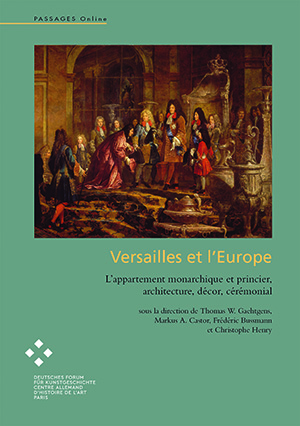
How to Cite
License

This work is licensed under a Creative Commons Attribution-ShareAlike 4.0 International License.
Identifiers
Published
Versailles et l'Europe
L’appartement monarchique et princier, architecture, décor, cérémonial
The volume presented here examines the influence of one of the most splendidly representative achievements of the early modern period upon the European courts of the 17th and 18th centuries. The Palace of Versailles was a showroom which made French luxury items known, and desired, far beyond the borders of France, drawing the attention of all regents of the time, and although numerous forms and ideas were borrowed by the artists and craftsmen who settled in the various European courts, the persistence of local traditions should not be under-estimated.
Starting with an analysis of the form and function of the Versailles apartments, the French model is considered for its influence upon the concept of the apartment at other European courts. The contributions to this volume analyse the interplay between architecture, décor and ceremony and the particular importance of the apartments for the representation of the court. The arrangement of the rooms is shown to be a complex referral system that decided the presentation of power and accessibility to the regent. The rationale of the interior design is only revealed through an interdisciplinary examination which also takes into consideration the social and political/historical conditions. Already existing traditions of the European houses were transferred and adapted, and therefore newly configured, as part of this process.
The first part of the volume concentrates on the model of the apartment developed in France and attempts an understanding of the complex development in Versailles up to 1701, within which the Chambre de Parade became the centrepiece of the Palace. The second part contains case studies of residences in the German-speaking countries and examines the complex exchange and variety of the heterogeneous solutions. The study concludes with contributions about various important European courts in England, Holland, Sweden, Poland, Spain and Italy.
__________
Le présent volume trouve son origine dans un projet aussi légitime qu’attendu : étudier l’influence sur les autres cours européennes de celle qui fut la plus brillante d’entre elles. Le château de Versailles, « showroom » étincelant contribuant à l’exportation des biens luxueux de la culture française hors des frontières, était au centre de tous les regards européens. Si des artistes et artisans français partis s’installer dans les pays germanophones empruntèrent nombre de ses formes et idées, sous-estimer la persistance des traditions locales serait néanmoins une erreur.
Analysant la forme et la fonction de l’appartement royal du château de Versailles, cet ouvrage examine sa portée en tant que modèle de référence pour les conceptions ultérieures d’appartements princiers en Europe. Le livre rassemble des travaux relatifs à l’architecture, à la décoration et au cérémonial des appartements des résidences royales et princières en Europe. L’accent est mis sur leur rôle spécifique dans le cérémonial de la cour. Dans cette perspective, l’effet conjoint de la disposition spatiale, de l’architecture et de la décoration apparaît comme un facteur complexe, influençant de manière considérable la mise en scène du pouvoir monarchique, la fonction de représentation du souverain et son accessibilité. C’est l’articulation interdisciplinaire des différents types de savoir qui permet de comprendre la logique d’aménagement des appartements des cours européennes, ainsi que leur usage et l’étiquette qui les gouvernait. Les traditions préexistantes des maisons européennes se voient repositionnées dans ce processus.
La première partie de cet ouvrage se concentre sur les appartements officiels français, qui, en tant que principal lieu à la mode au XVIIIe siècle, disposaient d’un important pouvoir d’attraction. Les premières contributions s’attachent surtout à présenter l’évolution complexe de l’appartement officiel du château de Versailles, des origines jusqu’en 1701, lorsque la chambre de parade devient le cœur architectural du château. La deuxième partie de l’ouvrage se consacre aux résidences du Saint Empire romain germanique. Le champ d’investigation s’étend enfin aux principales cours de Grande-Bretagne, des Pays-Bas, de Suède, de Pologne, d’Espagne et d’Italie. Les exemples analysés donnent un aperçu des échanges complexes et hétérogènes entre les cours européennes.






